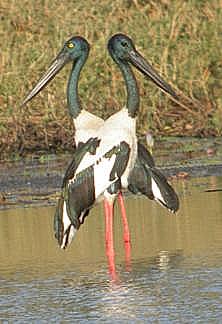|
| Query: Heron | Result: 1005th of 1105 | |
Black-necked Stork (Ephippiorhynchus asiaticus) - Wiki
| Subject: | Black-necked Stork (Ephippiorhynchus asiaticus) - Wiki
| |

| Resolution: 222x324
File Size: 17843 Bytes
Date: 2003:10:11 16:37:43
Camera: E4500 (NIKON)
F number: f/2.6
Exposure: 10/3584 sec
Focal Length: 269/10
Upload Date: 2007:10:23 17:40:25
|
Black-necked Stork
From Wikipedia, the free encyclopedia
[Photo] Black-necked Stork (Ephippiorhynchus asiaticus). Female with yellow and male with dark iris. Giru, Central Queensland Coast, October 2003. Date 11 October 2003. Author http://en.wikipedia.org/wiki/User:Tannin
The Black-necked Stork, Ephippiorhynchus asiaticus is a large wading bird in the stork family Ciconiidae. It is a widespread species, which is a resident breeder in southern Asia and Australasia, from India east to New Guinea and the northern half of Australia. In Australia, it is also known as a Jabiru but should not be confused with the similar bird of this name from the Americas, which belongs to a different genus.
The Black-necked Stork is a huge bird, typically 130-150 cm (51-60 inches) tall with a 230 cm (91 inches) wingspan. One (unsexed) bird weighed 4100 grams. It is spectacularly plumaged. The head, neck, wing bar and tail are jet black, with the rest of the plumage white. The massive bill is black and the legs are bright red. Sexes are identical except that the female has a yellow iris, while the male's is brown. Juveniles are mainly light brown with a white belly and dark legs.
Like most storks, the Black-necked Stork flies with the neck outstretched, not retracted like a heron.
The Black-necked Stork breeds in marshes and other wetlands in tropical lowland. It builds a stick nest in trees, laying three to five eggs. It often forms small colonies. The diet consists mainly of fish, frogs and large insects. Young birds, lizards and rodents also taken.
The only stork in Australia, this species is considered as endangered there. The Black-necked Storks are extremely sensitive to environmental changes like water pollution, habitat destruction and human disruption around breeding sites. It is evaluated as Near Threatened on the IUCN Red List of Threatened Species.
http://en.wikipedia.org/wiki/Black-necked_Stork
| The text in this page is based on the copyrighted Wikipedia article shown in above URL. It is used under the GNU Free Documentation License. You may redistribute it, verbatim or modified, providing that you comply with the terms of the GFDL. |
|
^o^
Animal Pictures Archive for smart phones
^o^
|
|

